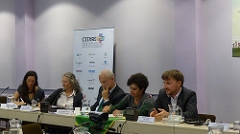
In the context of CIDSE’s international workshop “Climate and Agriculture: Harvesting people’s solutions for sustainable food systems”, an evening panel was organized on 19 September to build an interactive and dynamic discussion and confront different views on agroecology and climate-smart agriculture. The participants shared their reflections after the discussion in a series of flash interviews (links to watch the interviews are provided below).
This panel offered the opportunity for a frank discussion on policy options to shape sustainable food systems. Speakers who confronted each other on the topic of discussion were: Herwig Ranner, European Commission; Jacob Hansen, Director General of Fertilizers Europe; Teresa Anderson, Policy Officer, Climate & Resilience International at Action Aid; Paula Gioia, International Coordination Committee of La Via Campesina; George Fernandez Dixon, Secretary General of FIMARC- the International Federation of Rural Adult Catholic Movements; Doreen Stabinsky, Professor of Global Environmental Politics at the College of the Atlantic. Closing remarks were addressed by Bernd Nilles, Secretary General of CIDSE.
What’s the contribution of concepts such as climate-smart agriculture and agro-ecology in the development of sustainable food systems? How the transition towards sustainable food systems should look like? Looking at the Paris Agreement target of 1.5°C threshold, how will the agriculture sector contribute to stay below this temperature limit? What is the role for citizens, farmers, businesses in the transition towards sustainable food systems in a climate constraint world? These are some of the questions that guided the discussions.
The agroecological model was identified by some of the speakers as a the way forward for building sustainable food systems because of its capacity of conserving biodiversity and reducing the external input needed to farm and its characteristic of bringing together science and social aspects (George Dixon), because it is an effective adaptation solution in relation to water provision and because of its emphasis on diversification, crucial to get yield in cases of extreme weather (Teresa Anderson), for being a holistic approach not only looking at profit’s maximization but also at the overall societal well-being (Paula Gioia).
Herwig Ranner stressed that what counts is to be sustainable and reduce emissions, and that there are elements which should be taken into account for the future agriculture policy that are part of agroecology and others that are part of climate-smart agriculture. Jacob Hansen stressed on the importance of fertilizers, claiming that they will have to be part of the future if we want to feed the world.
During the debate the need to move fast towards sustainable food systems was also strongly highlighted. According to Doreen Stabinsky if we want to keep the temperature rise down we need to make a radical transformation happen, which requires the courage to creating a different world – “if we don’t change direction we are heading towards a global warming of 4°C, with all the terrible consequences that this will cause”.
In his conclusive remarks, Bernd Nilles stressed that despite many solutions to the climate and agricultural crisis already brought forward by the people, governments aren’t always operating in favor of them. He reminded that CIDSE expects governments to make the right choices for the people, but big business has a huge influence, making the choice between different types of solutions for the future of food systems not simply a technical question, but also a power struggle. Watch here the conclusive remarks by Bernd Nilles.
Participants were interviewed and shared their take-away from the discussion. Watch the flash interviews with:
• Teresa Anderson
• Paula Gioia
• George Fernandez Dixon
• Doreen Stabinsky
• Jacob Hansen
